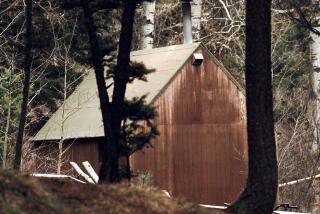‘Under the Dome’ by Stephen King
First, about that dome. We’ll be stuck under it with the residents of Chester’s Mill, Maine, for most of the thousand-plus pages of Stephen King’s impressive new novel, so a few facts may be handy.
For starters, it is invisible and impenetrable -- a force field, really, sci-fi flick allusions included. So its sudden manifestation one autumn day causes many bad things to happen. A plane crashes into the dome, some cars and a truck crash into it, flocks of birds crash into it and die. People die too.
And King handles these initial catastrophes as he will handle much of the mayhem ahead: with a grim yet almost jocular kind of matter-of-factness.
The most significant thing about the dome is that it prevents anyone from entering or leaving a small town that feels suddenly much smaller. Forget that some kids’ parents are out of town, or that most of the fire department happens to be away. The big problems stem not from what’s stuck outside, but from what’s stuck inside.
Is this your average New England village? The hometown pride, neighborly generosity and petty rivalries are unmistakably genuine. But Chester’s Mill seems to have extra room in its budget for dark secrets, religious and moral hypocrisy, and latent but powerful human malevolence. In other words, it’s a Stephen King kind of town (just up Route 117 from Castle Rock, for those keeping track). So the stage is set for an old-fashioned battle between good and evil, of the scope and intricacy King first achieved with 1978’s “The Stand.”
The good guys include Dale Barbara, a drifter who served in the Iraq War and is haunted by memories of something that went terribly wrong in a gymnasium in Fallujah. On his side are a physician’s assistant, the editor of the local paper and a computer-savvy kid and his skateboarding pals.
As for the bad guys? Nowhere in sight is King’s perennial antagonist, Randall Flagg, who apparently couldn’t bust through that dome either. But who needs the embodiment of evil when you have folks like Big Jim Rennie, owner of the local used-car lot and the town’s second selectman? Born-again Big Jim never utters a curse word (“clustermug,” “cotton-picking” and “rhymes-with-witch” are among his favorite turns of phrase), but he has the darkest of secrets to protect, as well as an insatiable hunger for power and control that needs only a nudge -- or in this case, the isolation afforded by an inexplicable force field -- to be kicked into high gear.
When that happens, and when a resistance rises up in opposition to his power grab, the result is a vivid and harrowing tale, expertly constructed, intensely moral and often thrilling, related with the masterful ease we have come to expect from its author.
That Rennie is the real star of the show says a good deal about King’s intentions. Rennie’s command comes from his ability to manipulate and his willingness to capitalize on the fear of others. “Fearful people need strong leaders,” he reflects, and the dome, he wants them to believe, is the result of a terrorist plot. Naturally, anyone opposing him must be in league with the plotters.
The atrocities pile up fast as King describes with lucid prose and chilling precision the genesis of a fascist regime. It’s rendered on a miniature scale but is all the more terrifying for the claustrophobia induced by the setting.
There are ecological problems to be reckoned with and questions of food and propane supplies. The story is overtly informed by certain contemporary horrors -- flashbacks to that gymnasium in Fallujah are especially fraught.
But let’s not call this political allegory. Let’s say instead that King is interested in portraying the everyday outrages that result when reason is abandoned for fear and panic, and that he knows where to look for examples.
Little wonder that the crime most consistently highlighted in “Under the Dome” is that of complicity. When you’re in the grips of a good book, King seems to say, it’s OK to sink in and enjoy the story. But when real human evil takes hold and the powers that be are transformed into the powers that shouldn’t, it is not all right to sit back and watch.
There is a tipping point in this novel. When things get so bad that the struggle between Rennie and his foes ceases to matter, the focus shifts, perhaps necessarily, back to the dome itself. Which is unfortunate, because the dome is significantly less interesting than what it inspires its captives to do.
By this point, however, King already has us.
“Under the Dome” is the work of a master storyteller having a whole lot of fun, and he makes it hard not to join in.
Berry is the author of the novel “The Manual of Detection” and assistant editor of Small Beer Press.
More to Read
The biggest entertainment stories
Get our big stories about Hollywood, film, television, music, arts, culture and more right in your inbox as soon as they publish.
You may occasionally receive promotional content from the Los Angeles Times.










